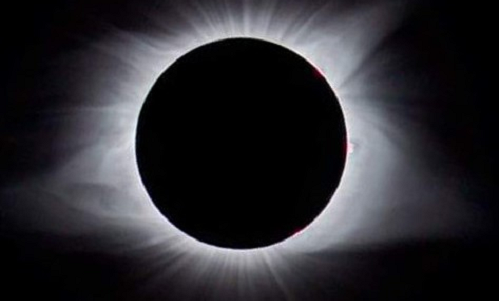The predictions made by Indian astronomers on how the Sun’s atmosphere, the Corona, would look like during the Great American Solar Eclipse were by and large accurate. The first images of the Sun’s corona during the eclipse show their prediction did indeed capture almost all the major features of the corona correctly.
Pune (ISJ) – The predictions made by a group of Indian astronomers on how the Sun’s atmosphere, the Corona, would look like during the Great American Solar Eclipse were by and large accurate.
The first images of the Sun’s corona on the day of the eclipse are now available and it is clear their prediction did indeed capture almost all the major features of the corona correctly. There are some finer details that their model was not able to reproduce, and it is expected that this will help them refine their models further and be ready in time for complementing the observations of the Aditya-L1 space mission.
The predictions were made by scientists led by Dr. Dibyendu Nandi from the Centre for Excellence in Space Sciences India, Indian Institute for Science Education and Research (IISER), Kolkata.
Based on their models of how the magnetic field of the Sun evolves, the team computed an image of the corona. They predicted two broad lotus petal-like structures (known as helmet streamers) on the southeast (lowerleft as viewed from Earth) and southwest (lower-right) edge of the Sun, and a third, narrow elongated streamer structure on the northwest (upper-right) edge of the Sun.
“These predictions have all been largely verified”, said Niruj Mohan Ramanujam, Chair of the Astronomy Society of India’s Public Outreach and Education Committee.
Preliminary inspection shows the team also predicted the right locations for all the streamers except the one on the southeast (lower-right) edge which is observed to be closer to the Sun’s equator than predicted. The prediction image however did not exactly capture the fine details in the structure that were observed, but this was expected since the model that was used was not complex enough to do so. The team also rightly predicted that the southeast (upper-left) edge of the Sun will be the least active.
“They will be performing a more detailed analysis as more data comes in, but we are very satisfied with the overall success of their prediction”, said Somak Raychaudhury, Director of IUCAA where Nandi is also an Associate.
“This close correspondence between their prediction and observations of all the major features of the Sun’s atmosphere is an impressive feat for a first attempt which utilized only modest and limited computing powers without recourse to supercomputers,” commented Durgesh Tripathi, a scientist at IUCAA who is developing the Solar Ultraviolet Imaging Telescope for the Aditya-L1 mission.
The team simulated the corona, without the use of supercomputers in such short a time. They realised that the overall structure of the solar corona was not heavily dependent on the most recent sunspots that appeared on the Sun’s surface. Instead, they realised that it was determined primarily by the accumulated history of how the magnetic field changed over the Sun’s surface. Hence, the Indian team managed to accurately model this magnetic field distribution as expected on the day of the eclipse by incorporating all the sunspots that have emerged on the Sun’s surface over the past century. They then fed this map of the predicted surface magnetic field for 21 Aug 2017 into their coronal model. Hence, using this idea allowed them to make this prediction with comparatively less powerful computers than the American group who were the only other team to have made such a prediction.
This success shows that the Indian astronomy community can now move towards more complex predictions of the space environment around Earth. This is crucial to protect our space assets like satellites, as well as telecommunication and aviation interests.
India is also planning to launch the Aditya-L1 space mission that will be dedicated to studying the Sun in order to understand its influence on our space environment and our climate.
“A coronagraph artificially creates a total solar eclipse in space by blocking the emission coming from the solar disk. The VELC can measure the coronal magnetic field and its structure, very similar to the modelled images of Nandi. The work by Nandi’s team will let us directly compare the observed images with these models and help us understand the corona better,” said Dipankar Banerjee of Indian Institute of Astrophysics and the science lead for the Visible Emission Line Coronagraph (VELC) instrument to fly on board the Aditya-L1 mission.
“On the day of the eclipse, all of us were glued to our computer screens watching the live broadcast of the eclipse on NASA TV,” said Dr. Nandi. Only late in the night in India they started getting observational results from the US which told them they can go to sleep in peace. The team is geared up to do a more detailed comparison with their models as more data comes in. “For us, life as a scientist goes on,” he added.


